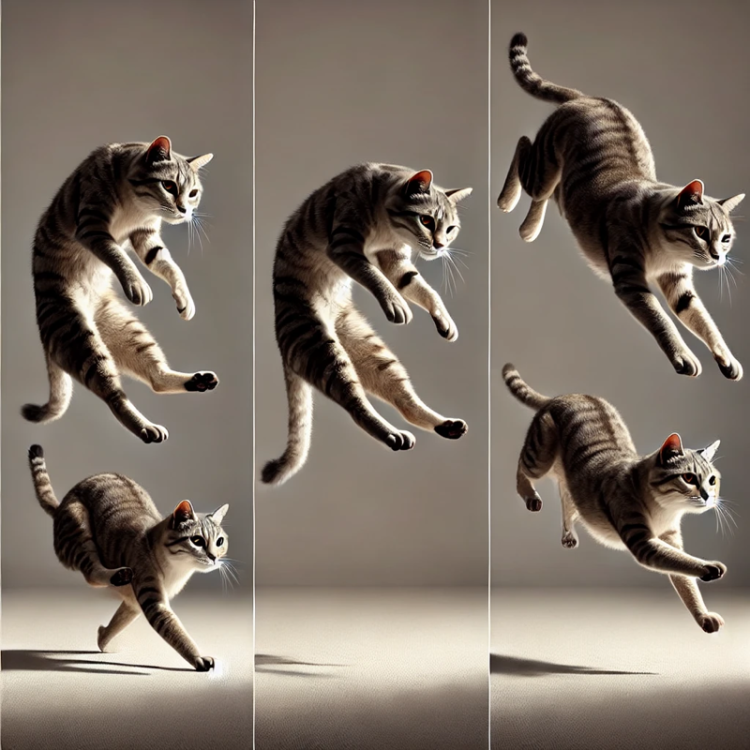The Amazing Science Behind How Cats Land on Their Feet
Cats have an extraordinary ability to twist in midair and land gracefully on their feet, even after falling from great heights. This is not magic or a supernatural event, but rather a remarkable physical process that can be explored and understood through science. The reason cats can do this lies in a unique combination of their inner ear, spine flexibility, and physics. It’s a skill called the righting reflex, and it kicks in as soon as a cat begins to fall. Scientists have spent over a hundred years studying how this works, leading to insights in everything from human balance to robotics.
The Righting Reflex: How Cats Flip Themselves Over
The secret to a cat’s landing begins with its vestibular system, which is found in the inner ear. This system works like a tiny biological gyroscope, constantly telling the cat’s brain which way is up. The moment a cat starts to fall, its brain recognizes that it is upside down and sends signals to the muscles, prompting it to start twisting its body.
A cat's spine is one of the most flexible in the animal kingdom. Unlike humans, who have limited mid-air control, a cat can rotate the front and back halves of its body independently. As soon as a cat begins to fall, it turns its head to face the ground, then twists its front legs in one direction while rotating its back legs in the opposite direction. This movement follows the laws of physics, particularly the conservation of angular momentum, which means that a cat can rotate in midair even without pushing off a surface.
When it nears the ground, the cat stretches out its legs to slow its fall, increasing air resistance like a parachute. As it lands, its legs bend deeply, absorbing the shock of impact. This is why cats, even after a significant fall, often walk away unharmed. However, if the height is too low, the cat might not have enough time to react, which is why falls from short distances can sometimes cause injury.
The Myth of the Tail: Is It Necessary for Landing?
Many people assume that a cat’s tail plays a crucial role in this reflex, but this isn’t true. While the tail does help with balance when a cat is running or jumping, it is not necessary for the righting reflex. Tailless cats, like the Manx breed, still perform the same mid-air twist and land safely. Instead of relying on their tails, they use their inner ear and spine flexibility to control their motion.
High Falls: The Cat Paradox
Can a Cat Suffer Internal Injuries from a Fall?
Absolutely. While their righting reflex and flexible limbs help distribute impact forces, they cannot fully prevent internal injuries in higher falls. Veterinarians have treated cats that fell from great heights, especially from buildings—a phenomenon sometimes called “high-rise syndrome.” Despite their ability to land on their feet, cats can suffer internal trauma upon impact. Their lungs may bruise due to sudden compression, and their diaphragm can tear as abdominal organs push upward. The liver and spleen, being dense and vulnerable, may sustain damage as well. Even though the legs absorb much of the landing force, if a cat’s head or chest makes contact with the ground, fractures in the jaw or ribs can still occur.
Why Do Some High Falls Seem Safer for Cats?
Veterinary studies have observed that cats falling from greater heights sometimes fare better than those falling from lower levels. This is likely because when a cat falls from more than five stories high, it reaches terminal velocity, meaning it no longer accelerates. At this point, it can spread its limbs outward, slowing the descent and allowing for a more controlled landing. Additionally, at greater heights, cats may have more time to adjust their posture and relax their bodies, which can help in reducing injury upon impact. However, internal injuries remain a risk. Even when a cat appears unharmed on the outside, the forces involved in a fall can still cause unseen damage within the body. Because of this, it is always best to have a fallen cat examined by a veterinarian to ensure there are no underlying injuries.
Veterinary studies have observed that cats falling from higher than five stories sometimes fare better than those falling from just a few stories. This is likely because:
-
They reach terminal velocity (the speed at which falling no longer accelerates), allowing them to spread their limbs and slow the fall.
-
They relax more at higher falls, reducing stiffness that could increase injury.
However, even in high falls, internal injuries are still a risk. The "third impact" still happens inside their bodies, meaning that just because a cat can walk away from a fall doesn’t mean it is unharmed.
What have we learned? 
Cats' ability to land softly reduces but does not eliminate the risk of internal injuries. The three-collision rule still applies—just on a different scale. If a cat falls from a high place, it’s always best to get it checked by a vet, even if it seems fine on the outside.
One of the most surprising scientific discoveries about cats is that they often survive higher falls better than shorter ones. This has been observed by veterinarians who have studied cats that have fallen from different heights. Falls from 2-6 stories are often more dangerous than falls from 7 stories or higher. The reason for this is that a falling cat reaches terminal velocity—the fastest speed it can fall—after about five stories. Once a cat reaches this speed, it relaxes and spreads out its legs, which slows its descent, much like a skydiver spreading their arms and legs to control their fall. In shorter falls, they don’t have enough time to do this, making injuries more likely. This discovery, often called the cat paradox, seems to defy common sense but has been confirmed by real-life cases.
What Other Animals Have Similar Abilities?
Although cats are famous for their ability to twist and land upright, they aren’t the only animals with impressive mid-air skills. Squirrels and lemurs use similar techniques when jumping between trees, relying on quick body rotations to control their landings. Human gymnasts also use similar physics when performing flips, adjusting their limbs to increase or decrease spin speed. NASA has even studied the way cats twist in free fall to understand how astronauts might move in space, where there is no gravity to assist with reorientation.
Science and Technology Inspired by Cats
The way cats land has fascinated scientists for decades, leading to many real-world applications. Engineers and roboticists have studied the mechanics of a cat’s landing to design robots that can flip themselves upright after falling. In medicine, researchers have examined how the righting reflex might help prevent injuries in elderly peopleby improving balance training techniques. Even space exploration has taken inspiration from cat movement, helping astronauts better understand how to move in a weightless environment.
Jehovah’s Wisdom in Creation
Looking at how a cat’s body works, it’s impossible to ignore the brilliance behind its design. Jehovah, the Creator of all living things, designed cats with incredible balance, reflexes, and flexibility. Everything about them—from their precisely tuned inner ear to their shock-absorbing limbs—shows careful planning. No random process could have created such a finely tuned system. The way cats survive falls and move with elegance is just another reflection of the wisdom and power of their Creator. Just like the rest of the natural world, they are a testament to Jehovah’s perfect design, giving us even more reason to appreciate the marvels He has made.
The Final Word
The mystery of how cats always land on their feet has fascinated humans for centuries. Thanks to scientific research, we now understand that this ability is the result of a combination of biology, physics, and engineering. Their highly sensitive vestibular system detects their orientation, their flexible spine allows them to twist in midair, and their natural parachute-like stance helps them control their fall. Even high-tech robots and astronauts have learned from their movements. And beyond science, their incredible abilities remind us of the wisdom behind their creation. Jehovah designed them with perfection, and it’s just one more reason to admire the wonders of the world He has made.
Sources
-
Veterinary Studies on Feline High-Rise Syndrome – Research on internal injuries in cats after falls.
-
Biomechanics Research on Impact Forces – Studies examining how falls affect internal organs in animals.
-
Étienne-Jules Marey’s Motion Studies (1894) – One of the first studies on how cats land.
-
NASA Zero-Gravity Experiments – Research on how cats move in weightlessness.
-
Veterinary Studies on Feline Falls – Studies showing that higher falls often result in fewer injuries.
-
Biomechanics Research – High-speed motion capture analysis of cat movement.
-
Robotics Research Inspired by Cats – Using feline mechanics in self-righting robots.
- Qapla, hatcheckgirl and Roxessence
-
 1
1
-
 1
1
-
 1
1


0 Comments
Recommended Comments
There are no comments to display.
Join the conversation with your brothers and sisters!
You are posting as a guest. If you are already a member, sign in now to post with your existing account.
Note: Your post will require moderator approval before it will be visible.